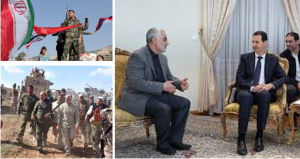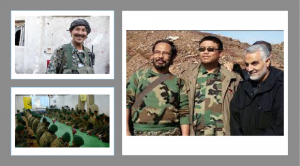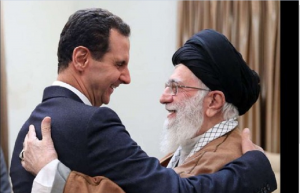
(Video)The Iranian Regime’s Role in Propping Up Bashar al-Assad in Syria
Iran’s financial commitment also deepened. Tehran funneled $15 billion annually to Syria, funding fuel shipments, weapons, for over 80,000 foreign fighters.
PARIS, FRANCE, December 23, 2024 /EINPresswire.com/ -- The National Council of Resistance of Iran (NCRI) Foreign Affairs Committee in an article published that on December 8, 2024, the Syrian people finally overthrew the brutal dictatorship of Bashar al-Assad, marking the end of a regime that had inflicted unimaginable suffering. To truly grasp the geopolitical consequences of this historic victory, it is essential to look back and examine the lengths to which the Iranian regime went to save Assad.
Drawing on a 2016 report published by the NCRI’s Washington, D.C. office, this article uncovers how Tehran poured billions into Syria, deployed thousands of proxy militants, and orchestrated atrocities that massacred the Syrian people all in a desperate bid to maintain its influence and prevent Assad’s fall.
Phase One: Early Intervention (2011-2013)
When protests erupted in Syria in March 2011, Iran’s Supreme Leader Ali Khamenei immediately categorized the uprising as a Western plot. By mid-2011, Tehran deployed the Quds Force under General Qassem Soleimani to Damascus to assist Assad’s forces in crushing dissent.
In 2012, Iran expanded its role by forming the National Defense Forces (NDF), a paramilitary group trained and equipped by the Islamic Revolutionary Guard Corps (IRGC).
The NDF operated in key locations such as Homs, Aleppo, and the Damascus suburbs. By 2013, over 10,000 IRGC operatives were reportedly embedded in Syria, with Tehran allocating an estimated $6 billion annually to sustain Assad’s regime. Soleimani frequently traveled to the frontlines, particularly near Damascus, to oversee operations personally.
Phase Two: Regional Proxy Deployment (2013-2015)
Iran’s proxy network became central to the war effort after Assad’s forces faced significant territorial losses in 2013. Hezbollah, Iran’s Lebanese proxy, spearheaded offensives in Qusayr (May 2013), a strategic city near the Lebanese border. The victory in Qusayr underscored Iran’s role in preventing rebel advances in western Syria.
During this period, Iran funneled an estimated $600 million annually to Hezbollah, ensuring their full commitment to Syrian operations. Simultaneously, Iran recruited fighters from impoverished Afghan and Pakistani communities, forming brigades such as the Fatemiyoun Division and the Zeinabiyoun Brigade.
These groups fought in pivotal battles, including the siege of Aleppo (2016), where indiscriminate bombing and ground assaults devastated civilian infrastructure. Afghan recruits were offered $500 monthly salaries, transportation, and promises of Iranian citizenship, while many were coerced into service.
Phase Three: Financial and Military Escalation (2015-2018)
By 2015, Assad’s regime was near collapse, controlling only 20% of Syrian territory. In July 2015, Qassem Soleimani traveled to Moscow to secure Russian air support, leading to coordinated Iranian Russian campaigns.
This partnership was pivotal in the retaking of Aleppo (December 2016), where Iranian proxies executed mass killings in neighborhoods like Bustan al-Qasr. The coordination between Russian airstrikes and Iranian ground forces became a model for subsequent offensives, including campaigns in Palmyra (2017) and Eastern Ghouta (2018).
Iran’s financial commitment also deepened. Tehran funneled $15 billion annually to Syria, funding fuel shipments, weapons, and salaries for over 80,000 foreign fighters.
Iranian advisors set up command centers in Latakia, Hama, and Deir ez-Zor, directing offensives against both opposition forces and ISIS. These command centers also served as logistical hubs for moving heavy weaponry and supplies across the region.
In 2017, Iranian-backed militias participated in the Deir ez-Zor campaign, securing critical oil fields along the Euphrates River. This economic lifeline bolstered Assad’s regime and strengthened Tehran’s grip on strategic resources. By 2018, Iran controlled oil revenues from fields such as Al-Omar, which accounted for millions in monthly income.
Phase Four: Chemical Weapons and Global Diplomacy (2013-2018)
Iran’s involvement extended to controversial chemical weapons incidents. Following the Ghouta chemical attack (August 2013), which killed over 1,400 civilians, Iranian advisors reportedly facilitated logistical support for Assad’s chemical arsenal. Tehran’s influence was critical in securing Russian diplomatic cover to prevent military intervention. Iranian officials issued direct warnings to the United States, threatening regional escalation if Assad’s forces were targeted.
Iran also intensified its propaganda campaigns. It portrayed its intervention as a “defense of holy shrines” like the Sayyidah Zaynab shrine near Damascus, exploiting religious sentiment to recruit fighters. Social media channels run by IRGC affiliates disseminated images of “martyred” fighters to reinforce narratives of religious duty.
Phase Five: Entrenchment and Humanitarian Atrocities (2018-Present)
By 2018, Iran’s entrenchment in Syria had transformed into a long-term occupation strategy. Iranian-backed militias controlled key border crossings like Al-Bukamal on the Iraq-Syria border, ensuring the flow of arms and fighters. In Idlib, Iranian forces coordinated with Russian and Syrian troops in relentless offensives, targeting hospitals, schools, and civilian shelters.
Humanitarian abuses reached alarming levels. In areas like Eastern Ghouta and Madaya, Iranian proxies enforced brutal sieges, leading to starvation and medical crises. Reports indicate that Iran-backed forces systematically displaced Sunni populations, replacing them with loyalist families to create demographic changes favorable to Assad’s regime. These efforts included forced relocations from Daraya (2016) and Qalamoun (2017).
Camps and Garrisons: Strategic Footprints of the Iranian Regime
The Iranian regime established an extensive network of camps and garrisons across Syria to maintain its military footprint and exert control. One of the largest bases, Imam Ali Military Base, located near Al-Bukamal, served as a hub for transferring weapons and fighters into Syria. This garrison hosted thousands of IRGC operatives and proxy forces and was fortified with underground tunnels and missile storage facilities.
Another critical base was T-4 Airbase near Homs, where Iranian drones were deployed for reconnaissance and attacks. This location was central to Iran’s logistical operations, ensuring supply lines to frontline militias. Camps such as Nayrab Military Airport in Aleppo also became key staging grounds for Iranian and Hezbollah fighters.
In southern Syria, Iranian militias operated out of Daraa and Quneitra, close to the Israeli border, escalating regional tensions. Reports suggest that over 80,000 militia members trained and operated out of these facilities, including the Fatemiyoun and Zeinabiyoun brigades. These garrisons often doubled as recruitment centers for locals, exploiting economic desperation to replenish their ranks.
The Defeat and Its Implications for Tehran
The overthrow of Assad by the Syrian people marks a catastrophic failure for Tehran. The collapse of its key ally dismantles the so-called “Shia Crescent,” severing its land bridge to Hezbollah and jeopardizing its influence in the region. The fall of Assad exposes the fragility of Tehran’s grand strategy, revealing the regime’s reliance on immense financial and human resources to sustain its proxies.
The Iranian regime invested billions and sacrificed thousands of militants to preserve Assad’s rule, yet it failed to prevent his downfall. This defeat erodes Tehran’s regional leverage, emboldens opposition forces, and signals to its proxies that Tehran cannot guarantee its survival.
Domestically, the loss has exacerbated public discontent over wasted resources, amplifying calls for accountability and change. Internationally, it leaves Khamenei’s regime more isolated, with calls for his ousting growing louder more than ever.
This defeat marks not just the end of a brutal dictatorship but a critical blow to Iran’s ambitions, shifting the balance of power in the Middle East and opening the door for greater democratic movements across the region.
Who Was the Vicious Criminal Qassem Soleimani.
If you wish to receive the NCRI weekly Newsletter, please use the following link to subscribe: https://bit.ly/3SMgEla.
Shahin Gobadi
NCRI
+33 6 61 65 32 31
email us here
In 2012, Iran expanded its role by forming the National Defense Forces (NDF), a paramilitary group trained and equipped by the (IRGC).
Distribution channels: Human Rights, International Organizations, Politics, U.S. Politics, World & Regional
Legal Disclaimer:
EIN Presswire provides this news content "as is" without warranty of any kind. We do not accept any responsibility or liability for the accuracy, content, images, videos, licenses, completeness, legality, or reliability of the information contained in this article. If you have any complaints or copyright issues related to this article, kindly contact the author above.
Submit your press release




